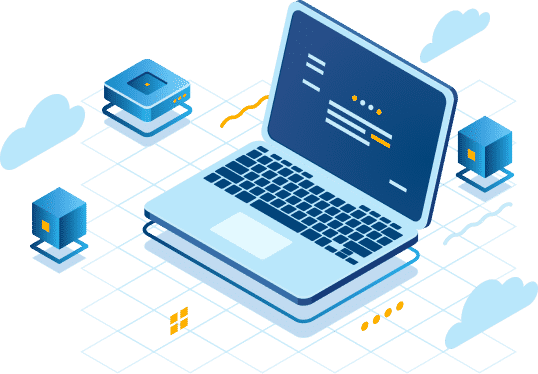MacOS Patch Management Software That Just Works
macOS Updates and Third-Party Patching
Real-time assessment of missing patches and compliance status
Custom application patching via Software Repository
No VPN is required for remote, off-site patching
Cross-platform: unified macOS and Windows patching
Unified Cross-OS Patch Management
Manage and update your Windows, macOS, and Linux endpoints directly in your browser from anywhere around the world with no VPN required. Action1’s Autonomous Endpoint Management platform delivers real-time visibility into vulnerabilities, missing patches, and compliance status, enabling your IT team to remediate security gaps with patch management software that just works.
Windows OS
Keep your Windows 10/11 and Windows Server endpoints secure and compliant by automating update/patch deployments and report generation in just a few clicks. Avoid unexpected downtime by remediating vulnerabilities with phased, risk-free, autonomous rollouts.
macOS
Automate patching across your entire macOS fleet. Identify vulnerabilities and missing updates in real time, test patches thoroughly, and schedule seamless deployments to turn manual patching into a set-it-and-forget-it process.
Linux
Keep your Debian and Ubuntu distributions secure and stable with automated updates that never fall behind (Red Hat and SUSE support coming soon). Less downtime, stronger security, no manual overhead—just patching that works.
What Is Patch Management?
Patch management is the process of remediating software vulnerabilities by sourcing, distributing and applying software updates. Patching is the most important part of a vulnerability management program. Implementing Action1 helps to fix security vulnerabilities in operating systems and applications before they are exploited by threat actors. Action1 automates the patching process per patch management best practices by identifying missing updates, testing, approving, scheduling and deploying patches, as well as generating status reports.
Automate the entire patch management process
Unlike other patch management tools, Action1 implements a reliable and consistent patch management process, regardless of where your endpoints are. It automates the entire software update process, from scanning your network for missing updates, to installing patch updates to multiple endpoints in minutes and reporting on compliance status.
Keep macOS patched
Patch third-party applications
Deploy patches for dozens of the most common applications, tested by Action1 team shortly after release, and save the hassle of checking vendors’ websites for the latest versions. Patch your custom applications from the same console.
Detect missing patches in real-time
See in seconds what OS and application patches are pending on what machines, either by an endpoint or by an update. Be notified about new macOS updates and missing software patches waiting to be rolled out.
Enforce patch management policy
Prioritize patches based on their security severity. Choose the patching schedule for update deployment to meet your patching policy requirements, assign patches between critical and non-critical endpoints, avoid patching overlaps and user downtime.
Test and approve patches
Deploy macOS updates and upgrades
Trusted by thousands of IT teams around the world


Why customers choose Action1
Patching without VPN
Patch remote and onsite endpoints with Action1 cloud-native platform. No company network or VPN connection required.
Ditch complexity
Start getting value in minutes, not hours or days. Deploy and patch software consistently without legacy technology, clunky integrations, or multiple consoles.
Unified, cross-platform patching
Secure and trusted
Action1 is the only patch management solution with both SOC 2 Type II and ISO 27001:2022 certifications.
Patch offline devices
Improve your patch success rates by automatically installing macOS and application patches, as soon as endpoints that have been offline come back online.
See phenomenal ROI
What Our Customers Say
Action1 helped us save about 125 hours per month by automating patch management. That’s a huge enabler to our business; as an MSP, the more you automate, the more money you save, and the more savings you can pass on to your customers.
I gotta tell you that Action1 has changed how I install updates — I feel like now I can sleep, knowing my clients are patched.
With Action1, I’m saving hours every week and bringing in better control and consistency across everything that we do. It was also very easy to deploy; I was able to quickly install it and ensure nothing was missed.
What Experts Say



Industry Awards






See #1 cloud-native patch management in action
Frequently asked questions
What is macOS Patch Management and why is it important?
MacOS Patch Management refers to the process of ensuring that macOS devices within an organization are consistently updated with the latest security patches, software updates, and bug fixes. This is crucial for protecting systems against vulnerabilities, enhancing software performance, and ensuring compatibility with new applications.
Without effective patch management, macOS devices are left vulnerable to cyber threats, which can exploit outdated software versions. Hackers often target known vulnerabilities in outdated operating systems and applications, so timely updates are essential for maintaining security. Furthermore, updates often include new features and performance enhancements that improve user experience and efficiency.
A well-executed macOS Patch Management strategy reduces downtime, mitigates security risks, and ensures compliance with regulatory standards, particularly in industries with stringent data protection laws. Automating macOS patching can also streamline IT operations by eliminating the need for manual updates and monitoring, allowing IT teams to focus on more strategic initiatives. Ultimately, macOS Patch Management is a proactive approach that safeguards data, enhances productivity, and ensures devices remain secure and operational.
How does macOS Patch Management work?
MacOS Patch Management involves several key steps to ensure devices are up-to-date and secure. The process typically begins with scanning devices across the network to identify outdated software or patches that need installation. Once vulnerabilities are detected, patches are scheduled and deployed to all relevant devices.
For deployment, IT administrators can use a patch management tool compatible with macOS, which automates the process and reduces the chance of human error. These tools often offer options to configure patching schedules to minimize disruption, such as applying updates during off-hours. Additionally, many patch management tools include options for testing patches on a subset of devices before a full rollout. This helps detect potential compatibility issues that could impact user productivity.
After patches are deployed, administrators usually conduct a verification process to confirm that updates were successful. Reporting tools within patch management solutions provide visibility into patch status across devices, ensuring compliance and allowing IT teams to address any missed updates. This entire process of scanning, deploying, testing, and verifying patches is automated in most advanced solutions, making macOS Patch Management an efficient and reliable way to keep systems secure and updated.
What are the benefits of automating macOS Patch Management?
Automating macOS Patch Management offers several advantages, primarily in efficiency, security, and compliance. With automation, patches are deployed as soon as they’re available, which helps close security vulnerabilities more quickly than manual patching. This immediacy reduces the time during which devices are exposed to cyber threats, enhancing the overall security posture of the organization.
Automation also alleviates the burden on IT teams by streamlining routine tasks associated with patch management. Instead of manually scanning, deploying, and monitoring patches, IT professionals can configure automated schedules, allowing them to focus on higher-value tasks. Furthermore, automated patching tools often allow for easy customization, such as setting specific times for patches to deploy, minimizing user disruption.
From a compliance perspective, automation ensures all devices consistently meet security standards required by various regulations, which is crucial for industries like healthcare and finance. Automated reports provide a clear record of patching activities, simplifying audits and ensuring compliance with organizational policies. Overall, automated macOS Patch Management increases operational efficiency, reduces downtime, and provides stronger, more consistent security for macOS devices.
What challenges are associated with macOS Patch Management?
While macOS Patch Management is essential, it comes with several challenges. One of the primary issues is the diverse software environment within most organizations, which includes a mix of Apple’s native applications and third-party software. Ensuring compatibility between these programs and new patches can be difficult, as certain updates may cause software conflicts, leading to potential disruptions for users.
Another challenge is coordinating patches across a dispersed network of devices, especially with remote work environments. For organizations with a distributed workforce, it can be challenging to ensure that patches reach all devices, particularly if they are not regularly connected to the corporate network.
Patch testing is also a key issue. IT teams often face pressure to apply patches quickly, yet untested patches can lead to unexpected system behavior. Striking a balance between speed and stability is crucial in managing these updates effectively.
Lastly, some users may defer or reject updates due to perceived inconvenience, which can leave devices vulnerable. Addressing these challenges requires a robust patch management strategy that includes compatibility testing, user training, and the use of specialized tools designed for macOS environments to enhance deployment reliability.
How can businesses implement a successful macOS Patch Management strategy?
Implementing an effective macOS Patch Management strategy involves a combination of proactive planning, the right tools, and clear policies. First, businesses should conduct an inventory of all macOS devices and software applications to understand their patching needs. This inventory helps in identifying which updates are critical and should be prioritized based on security risks.
Next, organizations should set up a regular patching schedule, ideally using automated tools that allow for scheduling updates during non-business hours to minimize disruptions. Testing patches on a small group of devices before a full deployment is also essential to catch potential compatibility issues early.
Policies should be established to ensure end-users do not delay or ignore patches, as unpatched devices can create security risks. Providing user education on the importance of updates can help foster compliance.
Finally, using a comprehensive patch management tool with reporting capabilities can help IT teams monitor patch status, confirm deployments, and generate compliance reports. This structured approach ensures that all macOS devices remain secure and compliant, minimizing risks and enhancing operational efficiency across the organization.






